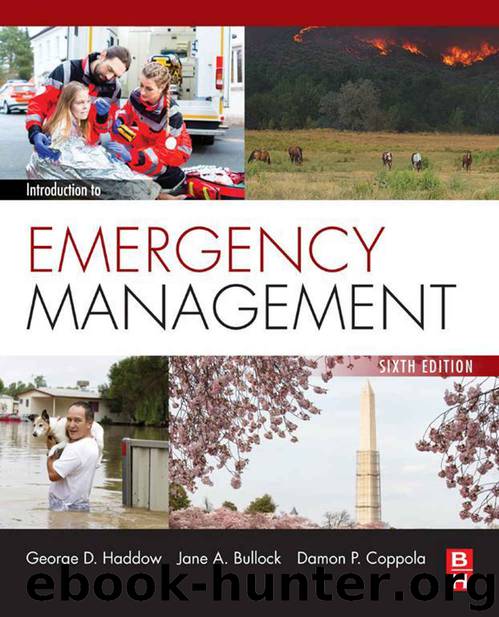Introduction to Emergency Management by Haddow George & Bullock Jane & Coppola Damon P

Author:Haddow, George & Bullock, Jane & Coppola, Damon P.
Language: eng
Format: epub
ISBN: 978-0-12-803065-3
Publisher: Elsevier Science
Published: 2017-01-08T16:00:00+00:00
Federal Assistance in Disaster Response
Federal disaster assistance can come from a number of initiating factors, but is most commonly associated with a presidential declaration and its statutory authority, the Stafford Act. Federal disaster assistance may be provided to state, tribal, and local jurisdictions, to other federal departments and agencies, and to private and nongovernmental sector organizations, in a number of different ways through various mechanisms and authorities all dictated according to eligibility.
Federal disaster assistance does not always require coordination by the Federal Emergency Management Agency, and may be provided without a presidential major disaster or emergency declaration. In such cases, the coordination of federal assistance may be initiated and led by other federal departments and agencies consistent with their authorities, such as with a public health emergency declared and managed by the Department of Health and Human Services, or an Agricultural Emergency Declaration as declared and managed by the Department of Agriculture (see Non-Stafford Act Federal Support to State and Local Jurisdictions below).
The vast majority of federally supported disaster events that are the result of the major natural and technological hazards described in this text, and which fall squarely under the purview of the local emergency manager, are typically those that require a presidential disaster declaration and which likewise are within the bounds of the Stafford Act. Federal support for such events is structured according to the National Response Framework and coordinated by the secretary of Homeland Security through FEMA.
Federal support to states and local jurisdictions under the Robert T. Stafford Disaster Relief and Emergency Assistance Act (The Stafford Act) occurs about 44 times each year on average (in addition to major emergency and fire management assistance declarations which provide more limited assistance). Before the declaration request is made, the governor must first activate their state’s emergency operations plan and procedures, and ensure that all appropriate state and local emergency response actions have been initiated within the limits of their capabilities. The affected area must be surveyed to determine the extent of private and public damage, and joint preliminary damage assessments must be conducted with FEMA officials to estimate the types and extent of federal disaster assistance that will be required.
Ordinarily, only the governor can initiate a request for a presidential emergency or major disaster declaration. In extraordinary circumstances, the president may unilaterally make such a declaration. The governor’s request is made through the FEMA regional administrator and based on a finding that the disaster is of such severity and magnitude that effective response is beyond the capabilities of the state and affected local governments and that federal assistance is necessary.
The governor’s request includes the following:
• Information on the extent and nature of state resources that have been or will be used to address the consequences of the disaster
• A certification by the governor that state and local governments will assume all applicable nonfederal costs required by the Stafford Act
• An estimate of the types and amounts of supplementary federal assistance required
• Designation of a State Coordinating Officer who oversees
Download
This site does not store any files on its server. We only index and link to content provided by other sites. Please contact the content providers to delete copyright contents if any and email us, we'll remove relevant links or contents immediately.
The Secret History by Donna Tartt(18943)
The Social Justice Warrior Handbook by Lisa De Pasquale(12165)
Thirteen Reasons Why by Jay Asher(8841)
This Is How You Lose Her by Junot Diaz(6831)
Weapons of Math Destruction by Cathy O'Neil(6214)
Zero to One by Peter Thiel(5730)
Beartown by Fredrik Backman(5673)
The Myth of the Strong Leader by Archie Brown(5456)
The Fire Next Time by James Baldwin(5380)
How Democracies Die by Steven Levitsky & Daniel Ziblatt(5170)
Promise Me, Dad by Joe Biden(5112)
Stone's Rules by Roger Stone(5051)
A Higher Loyalty: Truth, Lies, and Leadership by James Comey(4905)
100 Deadly Skills by Clint Emerson(4877)
Rise and Kill First by Ronen Bergman(4739)
Secrecy World by Jake Bernstein(4698)
The David Icke Guide to the Global Conspiracy (and how to end it) by David Icke(4655)
The Farm by Tom Rob Smith(4465)
The Doomsday Machine by Daniel Ellsberg(4449)
